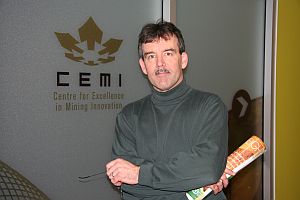 The Centre for Excellence in Mining Innovation (CEMI) has unveiled two new software tools to assess geotechnical risk and uncertainty. The Sudbury-based research organization worked with Mira Geoscience in Montreal to develop Geohazmap, a plug-in that works within its Gocad Mining Suite and with Rocscience Inc. of Toronto on refinements to its Phases2 software tool.
The Centre for Excellence in Mining Innovation (CEMI) has unveiled two new software tools to assess geotechnical risk and uncertainty. The Sudbury-based research organization worked with Mira Geoscience in Montreal to develop Geohazmap, a plug-in that works within its Gocad Mining Suite and with Rocscience Inc. of Toronto on refinements to its Phases2 software tool.
"It has become evident from discussions we had with mining company representatives that, as mines go deeper, one of the things they're concerned about is identifying, mitigating and managing risk or uncertainty," said Damien Duff, CEMI's R&D program manager.
"Managing risk is important, not only from a health and safety standpoint, but also from the point of view of the confidence investors have in these companies to do what they say they're going to do."
Gocad brings together individual datasets that collectively interact to identify which areas are likely to be more prospective for finding an orebody. Geohazmap uses the same approach to identify hazards in the underground geotechnical environment using data on rock strength, stresses and structure.
Vale Inco, Xstrata
CEMI worked with both Vale Inco and Xstrata Nickel to identify their needs, facilitated technical discussions with the software developers and managed the project.
Software developers at Mira Geoscience were able to work with a complete geological dataset for a portion of Xstrata Nickel's Craig Mine in Sudbury, said Duff.
From 2000 to 2009, Zones 10 and 11 at Craig Mine experienced 19 fault slip bursts, the most violent and disruptive kind of rockburst. Fortunately, none of these events resulted in a loss of life.
"We were able to use these known rockburst events and train the software to put together the right combination of geotechnical datasets to identify the chances of one of these fault slip rockbursts happening," said Duff.
If the software identifies a risk, corrective action can be taken to mitigate and manage it. "They can change the mining approach, the direction of the drift, the size of the opening, the rate of development or use a different ground support strategy."
According to Duff, mining companies do a great job collecting data, but they don't always do it in formats that are mutually compatible, so a great deal of time was spent pulling together the appropriate datasets, cleaning them up and reformatting them so they could talk to each other.
Range of values
The upgrade to Rocscience's Phases2 software tool will help geomechanics engineers assess the risk and uncertainty associated with mine openings by allowing for a range of values for each of the variables used.
"Until now, Phases2 allowed engineers to plug in a specific value for the parameters that might impact on the integrity of a mine opening," explained Duff. Using a range of values offers "a more probabilistic, rather than a deterministic approach."
Instead of identifying a rock stress value of 50 kilopascals, the geomechanics engineer can specify a range of, say, 80 to 100 kilopascals.
The approach compensates for the uncertainty associated with measurements in geomechanics and improves design reliability and risk evaluation.
Mira Geoscience and Rocscience will market these new tools. CEMI's role was limited to facilitating their development.
"You'd think that the mining companies would do it by themselves, but they don't necessarily get around to doing it," said Duff. "They're so preoccupied doing their day-to-day work that even something as obvious as this doesn't get a high priority. We recognize that at CEMI and are able to scope out a problem and get it done."
Ground stability is of increasing importance as mines go deeper.
"The average depth of a mine in Sudbury is probably between 4,500 and 5,500 feet, but Creighton Mine is already down to 8,000 feet with plans to go deeper and Kidd Creek in Timmins is down to 9,400 feet with plans to go to 9,600 feet and beyond that, so any tools we can develop to manage geotechnical risks will help the mining industry," said Duff.
www.miningexcellence.ca
www.rocscience.com
www.mirageoscience.com


